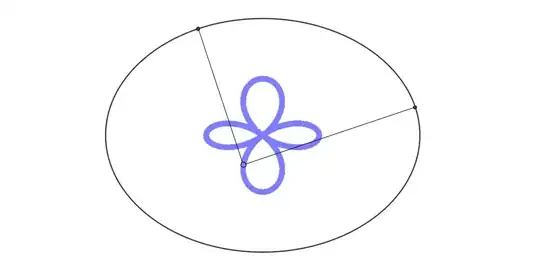I do not have even a sniff of a clue as to the stated question (the name of the curve), but I did find the formula for it.
Starting with an ellipse at origin, with axis-aligned semi-major axes $r_x$ and $r_y$,
$$\begin{align}
x_E(\varphi) &= r_x \cos \varphi \\
y_E(\varphi) &= r_y \sin \varphi
\end{align}$$
the normal (defined as tangent rotated 90° counterclockwise in a right-handed coordinate system) is
$$\begin{align}
x_N(\varphi) = \frac{d y_E(\varphi)}{d \varphi} &= r_y \cos \varphi \\
y_N(\varphi) = - \frac{d x_E(\varphi)}{d \varphi} &= r_x \sin \varphi
\end{align}$$
If the normals corresponding to $\varphi=\varphi_1$ and $\varphi=\varphi_2$ are perpendicular, then their dot product is zero,
$$x_N(\varphi_1) x_N(\varphi_2) + y_N(\varphi_1) y_N(\varphi_2) = 0$$
i.e.
$$r_y^2 \cos(\varphi_1) \cos(\varphi_2) + rx^2 \sin(\varphi_1) \sin(\varphi_2) = 0$$
Solving for $\varphi_2$ we get
$$\varphi_2 = - \arctan\left(\frac{r_y^2 \cos\varphi_1}{r_x^2 \sin\varphi_1}\right)$$
I shall use that to define a function
$$\theta(\varphi) = - \arctan\left(\frac{r_y^2 \cos\varphi_1}{r_x^2 \sin\varphi_1}\right)$$
The equation for the perpendicular line at $\varphi$, with $t$ as the line parameter is
$$\begin{cases}
x_1(\varphi, t_1) = x_E(\varphi) + t_1 x_P(\varphi) \\
y_1(\varphi, t_1) = y_E(\varphi) + t_1 y_P(\varphi)
\end{cases}$$
Using the function $\theta(\varphi)$ defined before, we know that the above is also perpendicular to
$$\begin{cases}
x_2(\varphi, t_2) = x_E(\theta(\varphi)) + t_2 x_P(\theta(\varphi)) \\
y_2(\varphi, t_2) = y_E(\theta(\varphi)) + t_2 y_P(\theta(\varphi))
\end{cases}$$
Their intersection occurs at
$$\begin{cases}
x_1(\varphi, t_1) = x_2(\varphi, t_2) \\
y_1(\varphi, t_1) = y_2(\varphi, t_2)
\end{cases}$$
which we can solve for $t_1$ and $t_2$. I shall omit $t_2$ here for brevity. $t_1 = t(\varphi)$:
$$t(\varphi) = r_x r_y \frac{ (r_x^2 - r_y^2) \cos(\varphi) - \sqrt{r_x^4 + \frac{r_y^4 \cos(\varphi)^2}{\sin(\varphi)^2}}}{(r_y^2 \cos(\varphi)^2 + r_x^2 \sin(\varphi)^2)\sqrt{r_x^4 + \frac{r_y^4 \cos(\varphi)^2}{\sin(\varphi)^2}}}$$
Note that $t(\varphi)$ is not defined at integer multiples of $\pi$ (including zero), but it approaches the value $$-rx/ry$$.
The curve is then
$$\begin{cases}
x'(\varphi) = x_E(\varphi) + t(\varphi) x_P(\varphi) \\
y'(\varphi) = y_E(\varphi) + t(\varphi) y_P(\varphi)
\end{cases}$$
Because of how we defined the normal, the actual curve is composed of two parts,
$$\begin{cases}
x(\varphi) = x'(\varphi) \\
y(\varphi) = y'(\varphi)
\end{cases}, \text{ and } \begin{cases}
x(\varphi) = -x'(\varphi) \\
y(\varphi) = -y'(\varphi)
\end{cases}, \; \; \varphi = (0, \pi)$$
In pseudocode (with ^ denoting exponentiation),
tmp1 = sqrt( rx^4 + ry^4 / sin(phi)^2 )
tmp2 = ( ( rx^2 - ry^2 ) * cos(phi) - tmp1 ) / ( tmp1 * ( rx^2 * sin(phi)^2 + ry^2 * cos(phi)^2 ) )
x = rx * ( 1 + tmp2 * ry^2 ) * cos(phi)
y = ry * ( 1 + tmp2 * rx^2 ) * sin(phi)
Each of the four lobes is $C^2$-continuous, as at $\varphi \to 0$ and $\varphi \to \pi$ the curve parts approach the origin at the same slopes.
 It looks like a four-leaf clover that is symmetric about the ellipse's axes. But what curve is this?
It looks like a four-leaf clover that is symmetric about the ellipse's axes. But what curve is this?